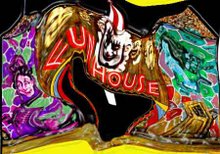Beth She'an Part Dos
After viewing the amphitheater we moved across (to the left in the big shot) toward the bath complex. As I have said before, Romans are all about the efficient moving and use of water and bathing was an advanced art.
Columns add elegance to the entrance to the baths, which offer all the benefits of a modern health club, from, exercising (wrestling and boxing) in the palaestra (courtyard outside) to cold and warm bathing and increasingly warmer temperatures. The floor mosaic from the palasetra above is geometric, but quite pretty.
Here you see more columns along the back and to the right the entrance to the caldarium,(hot bath).
Inside you can see how the floor was held up and vents were used to send the heat up from furnaces that heated the water.
This is an aerial photo that was taken of the site.
There were ususally three separate entrances, one for women, one for men and one for attendant slaves.
Here is a decorative fountain outside the calderium.
Nearby was a room for the latrines. This too was a social experience for the romans. They sat on boards over a channel of water and chatted while they did their business.
From the baths we moved to the merchant area along the main road and colonnade through the city.
There was a crescent of chops along the road (Not pictured here because I couldn't capture the nature of the semi-circle. Farther down the road were various buildings including temples and buildings we aren't really sure about. The consertavors left these columns down to show the effects of an earthquake on the area.
Farther to the right when you turn off the main road are more temples and buildings.
This is a tile floor we passed on that road perpendicular to the main drag. I've decided this must be a catfish.
Here is the tel behind the Roman city. It is at the top that the Egyptians established their town (and the stela was found).
Then our instructor Professor Nelson from CUNY led us off the trail to see the water source. Here is the wadi below (to the left off the perpendicular road to the main drag. (I believe that is in the Southwest section of the site.)
- I'm not sure, but we passed through on a road with a bunch of fallen
columns (to the right - not visible in the above image but can be seen below in the distance.)
...and there were clearly all kinds of unexcavated structures and
dwellings in the area.
Then we went off the road and were shown where the Wadi was.
We went down through the brush to some structures.
There were clear signs of Roman barrel arches there (as well as a bunch of cows on the other side of the arch.)
These pictures may not seem terribly spectacular next to the exotic images of columns and mosaics, but it is fascinating to see how expansive this site is and how many different civilizations have been here. On the way back we passed olive trees with olives ready to be harvested.(Bottom right)
Then we had free time to either climb the Tel or listen to our instructor explain a temple complex on teh Southwest corner of the site. I was tired and didn't know if I should try ot climb all those steps (I kind of wish I had - because there was quite a bit up on top of the Tel.
(This image is from: http://www.soniahalliday.com/images/IS725-4-44.jpg )
I decided that I should take advantage of having a live tourguide howver and it was extremely intersting - so there was no bad decision to make.)
This temple had fountains.
Here you can see a fountain basin in front of the temple , Behind it is a trough and three lion heads sprayed water into the trough.
זה אַריֵה.
(It is a lion!) And all too soon our trip was over. It was very hot and so I had my first ice cream since my arrival. All the National Park stores sell a variety of popsicles and icecream bars, so I bought one recommended by a fellow student and enjoyed it until the bus arrived. We headed back home with nice views of the Jordan and of course
... the Sea of Galilea.
I finally got a good view of this large, beautiful sea!




































No comments:
Post a Comment